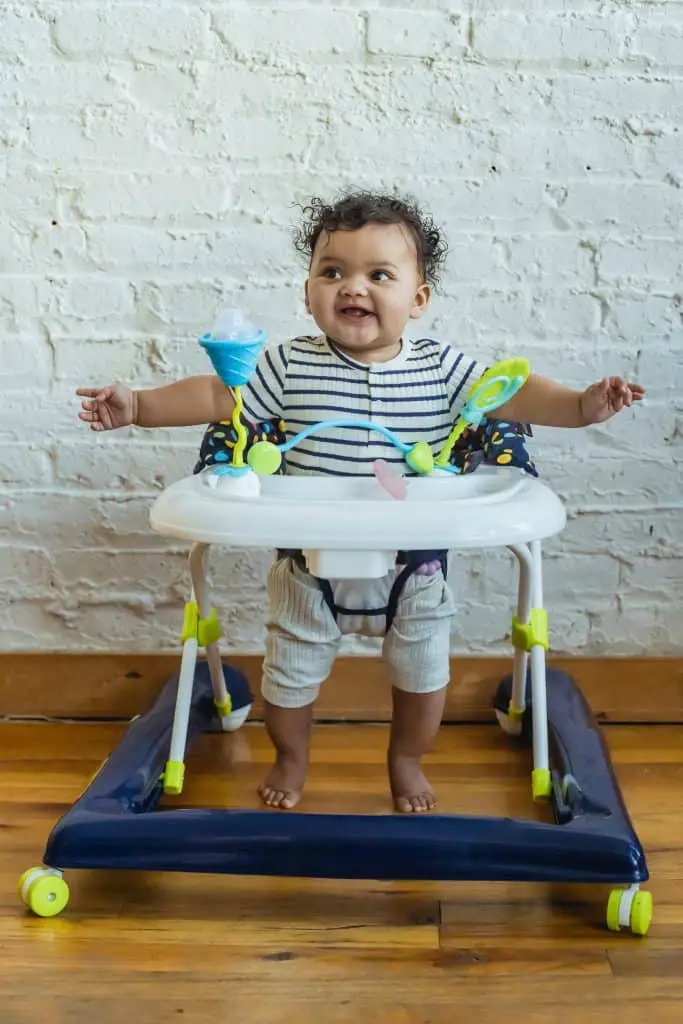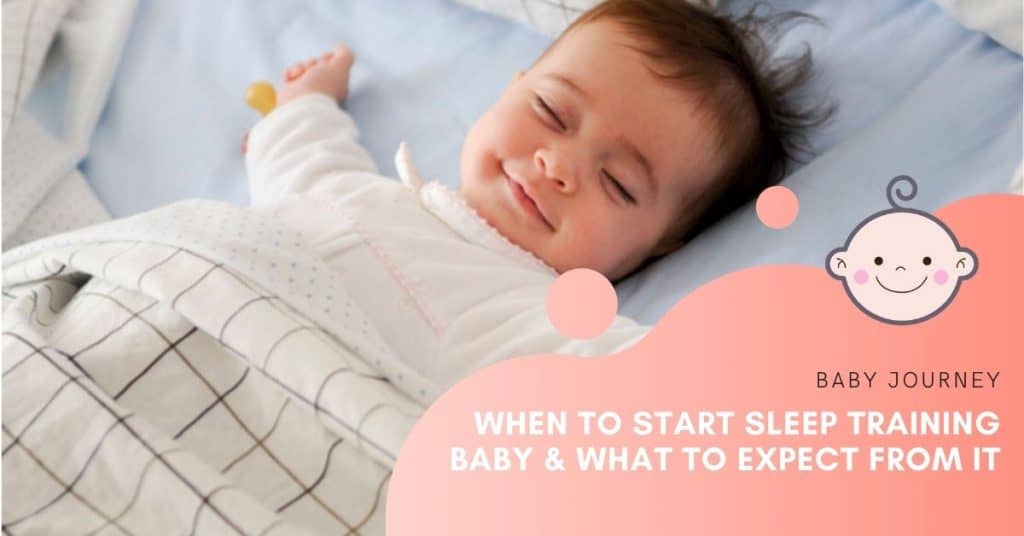“Sleep when baby sleeps,” they said.
The problem is, no one ever really says what to do when it’s been 3 months of baby barely sleeping and you are starting to hear colors.
I struggled through this exact situation in my first months as a new mom. At least until I discovered sleep training. Yet, even then, I did not fully understand how to do it or know when to start sleep training baby.
In the spirit of paying it forward, I have put together all the basics you need to know about sleep training to help you navigate it with ease. Let’s get into it, shall we?
What is Sleep Training?
Ordinarily, or at least in the newborn phase, most parents lull their babies to sleep in one way or another. It could be that you rock them, hold them, or that they simply fall asleep while breastfeeding.
Your baby soon becomes accustomed to this and it can get increasingly harder to get them to sleep when they should. In the long-run, this becomes unsustainable and is often the reason why most new parents are constantly exhausted.
Sleep training is a process through which you gradually help your child learn to fall asleep on their own. The goal is for them to no longer require you to soothe them persistently for them to sleep. Instead, it should be that when you put your sleep-trained child in their crib at their usual bedtime, they would self-soothe and sleep.
It is important not to confuse sleep training with night weaning. Sleep training is simply about establishing more independence when it comes to self-soothing to sleep. Night weaning [1], on the other hand, is gradually getting your child to stop waking up for night feedings. Unlike sleep training, night weaning is not particularly tied to helping your child sleep on their own.

When to Start Sleep Training Baby
If you are reading out of one eye due to being sleep-deprived, chances are you would like to start sleep training immediately. Not to rain on your parade, but there are certain conditions you should consider before you can begin sleep training.
Let’s have a look at some factors that can guide you on when and at what age to start sleep training.
Age
If you are still in the early newborn stage (0-3 months), it would be about too early to start sleep training. For starters, your little one just got here and this is a great time to bond with them and make them feel safe and loved. Plus, at this stage, it is unlikely that you have any set routines and your baby still needs to feed at night.
According to most pediatric experts, the best age to sleep train is around 4 months. Granted, this may still feel like an early start but your baby would be in a better place to handle it. Moreover, at around that age, most babies are able to sleep for longer without having to wake up to feed after short intervals.
Situational Timing
Eventful times like the holiday season or during transitions such as teething, weaning, or immunizations are not a good time to start. Your baby would already be navigating other challenges and adding sleep training to that would be too much for them to bear.
In contrast, when things are calm and you have managed to establish a routine for your baby, then it would be easier to introduce them to sleep training.
Keep in mind that this process can take a toll on you too. As such, if you are handling a big project at work or perhaps dealing with postpartum depression, try and find steady footing first before you start sleep training.
Suffice to say, if you are all in a state of wellness, sleep training is more likely to go better.

Doctor’s Orders
By the time I mentioned sleep training to our family pediatrician I was so sleep deprived it felt like I was losing track of days. I was, nonetheless, quite glad that I did because I learned that it is essential for your doctor to give you the all-clear before you start sleep training. This is because:
- Your baby’s weight may not be ideal and they may still require night feeding to achieve a healthier weight [2]
- If your baby has a health condition that requires monitoring, certain sleep training methods may be better than others
Barring these or any other issues, you could confidently go home ready to start the sleep training process with your doctor’s approval.
How Long Does Sleep Training Take?
I have always been of the opinion that everything about parenting is a process. Aside from my waistline that vanished overnight in the first trimester, that certainly happened quickly. I digress. What I meant to say is, the world is a strange new place for our babies and it is only natural that they learn from us gradually.
Sleep training, therefore, does not work after one night. If you are lucky your baby will have made peace with it after 3 to 4 nights. Even achieving consistency after a week is no mean feat. The key virtue to exercise here is patience because every child is different.
Nevertheless, I would recommend evaluating your progress to determine whether your efforts are working. For instance, is your baby crying for shorter periods before they sleep compared to when you started sleep training? Are they less irate when you place them in the crib and walk out of their room?
If you have followed a sleep routine for about two weeks or more with no results, you may want to consider changing your approach. It also would not hurt to consult your pediatrician or a baby sleep training expert. They might be able to point out why it is not working.
Popular Tried and Tested Sleep Training Methods
Every baby is unique and so different experts have come up with different sleep training methods over the years. The method you choose will probably depend on your baby’s age, health, temperament, and what you generally feel is best for them.
Here are the options you would have to choose from.
#1 The Chair Method
The chair method is a sleep training approach where you get your baby prepped for bed and then place them in their crib. You would then place a chair near their crib and wait for them to fall asleep. Each time they wake up you would come into the room and sit in the chair until they soothe themselves back to sleep in the crib.
As nights go by, you would gradually move the chair further and further away from the crib. Think of it slowly weaning them off of your presence. Eventually, the chair would get to the door, and hopefully, they would be able to sleep without you being in the room.
The idea here is that your baby would feel comforted by your presence and have an easier time soothing themselves to sleep. Soon enough they would be so used to self-soothing, that they just do it naturally even if you are not in the room.
This method is recommended for older babies aged around a year or thereabouts. It is normal for some babies to wail when they wake and realize that you left the room but if you are consistent they may soon get past that.
#2 The Cry-It-Out Method
In the cry-it-out approach, you get your baby dressed for bed in pajamas and a fresh diaper and then place them in bed. You would then leave the room and allow them to fall asleep on their own. Usually, most babies express their disapproval of your actions by crying out for you.
However, in this method, you are to let them cry out their frustration or disapproval without going to pick them up to soothe them as soon as you hear them crying. Admittedly, it is difficult to hear your baby crying and not do anything about it but try and stay the course.
However, if your baby’s cry sounds unusual, or if they begin to cough, throw up or get overly agitated, it is best to check up on them. Extreme responses are never a good sign. You could always consult your sleep training consultant or your pediatrician and find a method that could work better.
#3 No-Cry Method
The no-cry method is also known as the no tears method. It takes a more gradual approach to encouraging your tot to lull themselves to la-la-land.
The trick is to wean your baby off the things you do to soothe them to sleep. For example, if you usually hold and rock them until they are asleep, start cutting back the length of those sessions. This way when you eventually place them in their crib without the soothing routine, it will not be random. It will be something you have been slowly building up to and preparing them for.
Alternatively, you could try and switch up the soothing methods to more independent activities. For instance, as opposed to holding your baby and waiting for them to sleep, you could place them in the crib and sing them a lullaby.
The no-cry method might be a good option for you if you worry that the cry-it-out would be too hard for you or your child.
#4 Ferber Method
The Ferber method is a spin-off of the cry-it-out method but with crib training.
It begins with settling your baby into their crib at bedtime and leaving the room. If this unsettles them, let them cry it out. If they are still crying after 10 minutes you could go into their room to pat and shush them then leave again. You do not need to lift them off the crib.
In the beginning, you could try and console your baby after 10-15 minute intervals. As days go by, you can take longer to respond and just pat or reassure them while they are in the crib.
The pat, shush, and leave may happen a couple of times before they finally sleep. The cry-it-out sessions may also happen for a couple of nights before your baby begins to self-soothe.

Source: Pexels
#5 The Weissbluth Method
If I ever get to sleep train again, I would try the Weissbluth method. This is because I feel that when you do get the hang of it, it works just as well for parents as it does for babies. Here is why.
In this method, you would need to establish a bedtime routine for your child. [3] It could be that you change them in their non-toxic changing pad and massage them then read them a story, or sing them a lullaby as you place them in their crib. When that is done, you could dim the lights and turn on some white noise through a baby monitor then leave.
After you have left the room the next time you go in there would only be under special circumstances. Even if the child cries, just leave them be until they choose to soothe themselves.
The goal of the bedtime routine is to help your baby identify that it is time to sleep. The more you do it the more they will associate the routine with sleep. The upside is that these sleep associations allow you to be affectionate but they also teach your child to self-soothe.
If you are suffering from a disoriented sleep pattern, this sleep routine exercise could work for you too and is actually recommended by sleep experts. Your body will soon learn to naturally mellow out as you go about your bedtime routine thereby making it easier to fall asleep.

#6 Pick-Up-Put-Down Method
The pick-up and put-down method is a lot like the Ferber method. It entails letting your little screamer cry for short durations before going to check on them. In the Ferber method, you only pat and shush the baby in the crib. However, in the pick-up-put-down method, you can pick your child from the crib and hold them for a little while before placing them back in the crib.
The sessions could happen a couple of times through the night. The goal is to help the child understand that you are there for them but also to encourage them to fall asleep by themselves.
It requires lots of dedication but I feel that it could take longer for your baby to sleep train than other methods because they would still be relying on you to soothe them.
What to Expect While Sleep Training
When it comes to parenting experiences, I prefer to tell it like it is because the truth could help you be better prepared. So, here is what you expect as you transition into sleep training.
- Your baby might get cranky for the first few days- did you ever get mad at your parents for grounding you? Well, your baby might get cranky too after you introduce a sleep training technique. It’s their little way of saying they are not amused by your little parenting stunts but remember it is for their own good.
- You will want to quit- listening to your baby cry is very different from listening to your favorite record. It will make you sad and stressed and you will want to quit very often. Don’t. Think about how much healthier they will be with their sleep routine in check.
- It is okay to change methods- if you do not see any progress despite being consistent with the sleep training, it is okay to consult and change methods. Choosing how to sleep train a baby should be a flexible process based on what works.
- Different strokes– just like potty training your child, sleep training for babies is very individual. Even siblings can require entirely different sleep training approaches. So, while recommendations are great, try and figure out what specifically works for you and yours.
- Invest in a baby monitor- the one thing that kept me sane during our sleep training phase was having a video baby monitor. I could check in on my daughter and console myself that she was okay and that the crying would soon stop. Some new model video monitors even allow you to play lullabies which could be very helpful in calming babies.
 video baby monitor enables you to keep an eye on your baby while sleep training. -When to Start Sleep Training Baby & What to Expect From It | Baby Journey” class=”wp-image-18240″ width=”480″ height=”383″/>
video baby monitor enables you to keep an eye on your baby while sleep training. -When to Start Sleep Training Baby & What to Expect From It | Baby Journey” class=”wp-image-18240″ width=”480″ height=”383″/>Frequently Asked Questions About Sleep Training
Is it okay to let a newborn cry itself to sleep?
No. In the newborn phase (0-3 months) your baby is very fragile and is only getting used to their surroundings. Your reassurance is important for their wellness and it helps create a bond between you.
Can you sleep train a 2-month old?
No, it is not recommended. At that age, your baby still requires multiple night feeds and diaper changes in the night. They are simply not ready for sleep training and it would be way more hectic training a 2-month old than sleep training a 4-month old who requires less nighttime feeding and such.
Is 6 pm too early for baby bedtime?
Not at all. As long as their routine has been active enough to exhaust them, there is nothing wrong with an early bedtime. The secret here is to get them to bed when they are just this side of tired but not overly exhausted or hyper.
Alternatively, you could set their bedtime at the time of day when you regularly notice them yawning and getting drowsy.

Source: Pexels
When should you start sleep training using the Ferber method?
6 months and over would be a good time to try the Ferber method. Younger babies might feel abandoned and confused if you subjected them to this method.
What sleep training method should I start with?
The answer to this question largely depends on your child’s age. If you are creating a sleep training schedule for a child under 6 months, the pick-up-put-down could be an easy sleep training method to use. This is because it allows you to comfort the baby and reassure them by touching or holding them.
You may be interested in: Should Babies Sleep in The Dark
Do doctors recommend sleep training?
Most of them do. However, the one thing they all agree on is that if you choose to sleep train, you should seek guidance from your pediatrician.
Conclusion
Sleep is important for physical and emotional wellness. Therefore, by sleep training baby, you could help improve both their wellness and your own.
Remember to take your time to first create a daily routine and learn your baby’s needs. Once this is in place, it will be much easier to choose and implement a sleep training plan.
I would love to hear what your experiences have been like. Have you tried sleep training? If so, what methods worked, and which ones turned out to be a non-starter? Do let me know in the comments.
—




